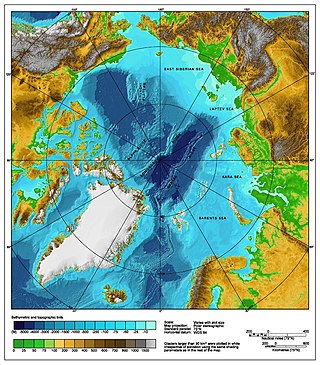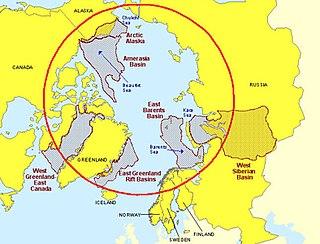Related Research Articles

The Arctic is a polar region located at the northernmost part of Earth. The Arctic region, from the IERS Reference Meridian travelling east, consists of parts of northern Norway, northernmost Sweden, northern Finland, Russia, the United States (Alaska), Canada, Danish Realm (Greenland), and northern Iceland, along with the Arctic Ocean and adjacent seas. Land within the Arctic region has seasonally varying snow and ice cover, with predominantly treeless permafrost under the tundra. Arctic seas contain seasonal sea ice in many places.

The Northeast Passage is the shipping route between the Atlantic and Pacific Oceans, along the Arctic coasts of Norway and Russia. The western route through the islands of Canada is accordingly called the Northwest Passage (NWP).

The Northern Sea Route (NSR) is a shipping route about 5,600 kilometres (3,500 mi) long, defined by Russian legislation as running from the entrances to the Novaya Zemlya straits in the west, along the Russian Arctic coast above Siberia through the Kara Sea, Laptev Sea, East Siberian Sea, and Chukchi Sea, to Cape Dezhnyov on the Bering Strait, at parallel 66 ° N and meridian of 168 ° 58′37 ″ W.

The Arctic Council is a high-level intergovernmental forum that addresses issues faced by the Arctic governments and the indigenous people of the Arctic region. At present, eight countries exercise sovereignty over the lands within the Arctic Circle, and these constitute the member states of the council: Canada; Denmark; Finland; Iceland; Norway; Russia; Sweden; and the United States. Other countries or national groups can be admitted as observer states, while organizations representing the concerns of indigenous peoples can be admitted as indigenous permanent participants.

The Arctic consists of land, internal waters, territorial seas, exclusive economic zones (EEZs) and international waters above the Arctic Circle. All land, internal waters, territorial seas and EEZs in the Arctic are under the jurisdiction of one of the eight Arctic coastal states: Canada, Denmark, Finland, Iceland, Norway, Russia, Sweden and the United States. International law regulates this area as with other portions of Earth.

Xue Long is a Chinese icebreaking research vessel. Built in 1993 at Kherson Shipyard in Ukraine, she was converted from an Arctic cargo ship to a polar research and re-supply vessel by Hudong–Zhonghua Shipbuilding of Shanghai by the mid-1990s. The vessel was extensively upgraded in 2007 and 2013.

Polar Class (PC) refers to the ice class assigned to a ship by a classification society based on the Unified Requirements for Polar Class Ships developed by the International Association of Classification Societies (IACS). Seven Polar Classes are defined in the rules, ranging from PC 1 for year-round operation in all polar waters to PC 7 for summer and autumn operation in thin first-year ice.
The Ilulissat Declaration is a document signifying necessary joint regional efforts and responsibilities in response to the potentially adverse effects of climate change with regard to the melting Arctic ice pack.
The Chinese Arctic and Antarctic Administration
(simplified Chinese: 国家海洋局极地考察办公室; traditional Chinese: 國家海洋局極地考察辦公室; pinyin: Guójiā hǎiyáng jú jídì kǎochá bàngōngshì), often abbreviated as the CAA, is a Beijing-based agency of the People's Republic of China's State Oceanic Administration (SOA). Established in 1981, it organizes China's scientific program for both the Arctic and Antarctic, and it provides logistic support to Antarctic expeditions. There are several divisions, including General Affairs, Operation & Logistics, Science Programs, International Cooperation, representation in the Chinese Embassy in Chile, and a Winter Training Base. The director is Qu Tanzhou.

Arctic cooperation and politics are partially coordinated via the Arctic Council, composed of the eight Arctic nations: the United States, Canada, Iceland, Norway, Sweden, Finland, Russia, and Denmark with Greenland and the Faroe Islands. The dominant governmental power in Arctic policy resides within the executive offices, legislative bodies, and implementing agencies of the eight Arctic nations, and to a lesser extent other nations, such as United Kingdom, Germany, European Union and China. NGOs and academia play a large part in Arctic policy. Also important are intergovernmental bodies such as the United Nations and NATO.

The Arctic policy of the United States is the foreign policy of the United States in regard to the Arctic region. In addition, the United States' domestic policy toward Alaska is part of its Arctic policy.
Sea transport accounts for most of the European Union's external and internal commerce. The EU is the world's third-largest importer of fisheries and aquaculture products and the fifth-largest producer. Maritime borders make up more than 70% of the Union's external borders, and hundreds of millions of travelers pass through European ports each year. The security of Europe's energy supply is heavily reliant on marine transit and infrastructure. The significant expansion of EU Member States' fleets, as well as suitable port infrastructure, contribute to a well-functioning energy market and supply security, and hence to European residents' and the European economy's overall well-being. The Arctic region is therefore a vital new area for the EU to work towards and a new strategy for the Arctic region that matches with the European Green deal was established in late 2021.

The Arctic policy of Russia is the domestic and foreign policy of the Russian Federation with respect to the Russian region of the Arctic. The Russian region of the Arctic is defined in the "Russian Arctic Policy" as all Russian possessions located north of the Arctic Circle. Approximately one-fifth of Russia's landmass is north of the Arctic Circle. Russia is one of five littoral states bordering the Arctic Ocean. As of 2010, out of 4 million inhabitants of the Arctic, roughly 2 million lived in arctic Russia, making it the largest arctic country by population. However, in recent years Russia's Arctic population has been declining at an excessive rate.
Arctic policy of South Korea is South Korea's foreign relations with Arctic countries, and its attitudes and actions on issues occurring within the geographic boundaries of "the Arctic" or related to the Arctic or its peoples.
Yamal LNG is a joint venture based around a liquefied natural gas plant located in Sabetta at the north-east of the Yamal Peninsula, northwest Siberia, Russia. In addition to the LNG plant, the project includes production at the Yuzhno-Tambeyskoye gas field, and the transport infrastructure, including the Sabetta seaport and airport.

The Transpolar Sea Route (TSR) is a future Arctic shipping route running from the Atlantic Ocean to the Pacific Ocean across the center of the Arctic Ocean.
Pollution in the Arctic Ocean is primarily the result of economic activities carried out on land, which is sources from locally, regionally, and globally origins. There is also the inclusion of industrial development in the Arctic region, northern rivers, and the effects of military activities, particularly nuclear activity – as well as the influx of pollutants from other regions of the world.However, the Arctic Ocean remains relatively clean compared to other marine regions of the world.

Arctic shipping routes are the maritime paths used by vessels to navigate through parts or the entirety of the Arctic. There are three main routes that connect the Atlantic and the Pacific oceans: the Northeast Passage, the Northwest Passage, and the mostly unused Transpolar Sea Route. In addition, two other significant routes exist: the Northern Sea Route, and the Arctic Bridge.

The Arctic resources race is the competition between global entities for newly available natural resources of the Arctic. Under the United Nations Convention of the Law of the Sea, five nations have the legal right to exploit the Arctic's natural resources within their exclusive economic zones: Canada, Russia, Denmark, Norway, and the United States.

MV Xue Long 2 is a Chinese icebreaking research vessel that entered service in 2019. She follows the naming of MV Xue Long, China's first polar research vessel.
References
- 1 2 3 Ngila, Faustine (April 20, 2023). "China is cementing its position as an Arctic superpower through Russia". Quartz . Retrieved April 20, 2023.
- ↑ Jash, Amrita. "IPP REVIEW--China's Need to Build the "Polar Silk Road"". ippreview.com. Archived from the original on 2018-09-04. Retrieved 2018-09-04.
- ↑ Brady, Anne-Marie (December 10, 2019). "Facing Up to China's Military Interests in the Arctic". Jamestown Foundation . Archived from the original on April 7, 2020. Retrieved 2019-12-13.
- ↑ Jüris, Frank (2020-03-07). "Handing over infrastructure for China's strategic objectives: 'Arctic Connect' and the Digital Silk Road in the Arctic". Sinopsis. Archived from the original on 2020-04-08. Retrieved 2020-05-09.
- 1 2 3 4 5 6 7 8 9 10 11 12 "Full text: China's Arctic Policy". english.gov.cn. Archived from the original on 2018-02-01. Retrieved 2018-01-31.
- 1 2 3 4 5 6 Dams, Ties; van Schaik, Louise; Stoetman, Adája (2020). Presence before power: why China became a near-Arctic state (Report). Clingendael Institute. pp. 6–19. JSTOR resrep24677.5 .
- 1 2 "China defines itself as a 'near-arctic state', says SIPRI". Stockholm International Peace Research Institute. 2012. Archived from the original on 2017-10-30. Retrieved 2017-10-29.
- ↑ Wright, David Curtis (2011). The dragon eyes the top of the world: Arctic policy debate and discussion in China (PDF). Naval War College Press. p. 8. Archived from the original (PDF) on 2017-05-13. Retrieved 2017-10-29.
- ↑ "List of countries by northernmost point", Wikipedia, 2023-07-30, retrieved 2023-08-01
- ↑ Lasserre, Frédéric; et al. (2017). "China's strategy in the Arctic: threatening or opportunistic?" (PDF). Polar Record . 53: 31. doi:10.1017/S0032247415000765. hdl: 20.500.11794/876 . S2CID 131750098. Archived (PDF) from the original on 2017-12-02. Retrieved 2020-05-12.
- ↑ Spears, Joseph (2011). "A Snow Dragon in the Arctic". Asia Times Online. Archived from the original on 2014-01-03. Retrieved 2017-10-29.
{{cite web}}: CS1 maint: unfit URL (link) - 1 2 "Naval War College - China Maritime Studies Institute: The Dragon Eyes the Top of the World" (PDF). Archived from the original (PDF) on 2012-10-17. Retrieved 2012-10-04.
- ↑ "China Prepares for an Ice-Free Arctic" (PDF). Archived from the original (PDF) on 2013-02-20. Retrieved 2012-10-04.
- ↑ FU.S.-China Economic and Security Review Commission Staff Research Report Archived 2012-10-02 at the Wayback Machine
- ↑ Icebreaker Xuelong concludes Arctic expedition Archived 2012-09-29 at the Wayback Machine China Daily
- 1 2 3 4 5 "Snow dragons: As the Arctic melts, Asia shudders at the risks but slavers at the opportunities" Archived 2012-10-09 at the Wayback Machine The Economist
- 1 2 Twelve non-arctic countries have been admitted as observers to the Arctic Council Archived 2013-10-20 at the Wayback Machine the Arctic Council
- 1 2 3 4 5 Buixadé Farré, Albert; Stephenson, Scott R.; Chen, Linling; Czub, Michael; Dai, Ying; Demchev, Denis; Efimov, Yaroslav; Graczyk, Piotr; Grythe, Henrik; Keil, Kathrin; Kivekäs, Niku; Kumar, Naresh; Liu, Nengye; Matelenok, Igor; Myksvoll, Mari; O'Leary, Derek; Olsen, Julia; Pavithran .A.P., Sachin; Petersen, Edward; Raspotnik, Andreas; Ryzhov, Ivan; Solski, Jan; Suo, Lingling; Troein, Caroline; Valeeva, Vilena; van Rijckevorsel, Jaap; Wighting, Jonathan (October 16, 2014). "Commercial Arctic shipping through the Northeast Passage: Routes, resources, governance, technology, and infrastructure" (PDF). Polar Geography . 37 (4): 298–324. doi: 10.1080/1088937X.2014.965769 .
- 1 2 3 4 5 Diplomat, Trym Aleksander Eiterjord, The. "China's Busy Year in the Arctic". The Diplomat. Archived from the original on 2019-06-03. Retrieved 2019-06-03.
{{cite web}}: CS1 maint: multiple names: authors list (link) - ↑ FU.S.-China Economic and Security Review Commission Staff Research Report Archived 2012-10-02 at the Wayback Machine
- ↑ Wade, R., ‘A warmer Arctic needs shipping rules’, Financial Times, 16 Jan. 2008.
- ↑ China Maritime Studies Institute: The Dragon Eyes the Top of the World Archived 2012-10-17 at the Wayback Machine , Naval War College
- ↑ European Parliament. "China's Arctic policy" (PDF). Archived (PDF) from the original on 2019-05-22.